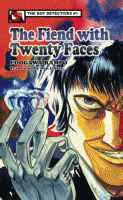 Author: Edogawa Rampo
Author: Edogawa Rampo
Illustrator: Tim Smith 3
Translator: Dan Luffey
U.S. publisher: Kurodahan Press
ISBN: 9784902075250
Released: March 2012
Original release: 1936
Edogawa Rampo, the pen name of Tarō Hirai, was one of Japan’s preeminent authors of the erotic grotesque nonsense movement. However, he was also well-known for his detective and mystery stories. Later in his career he even wrote a series for children called The Boy Detectives. The first and possibly best-known novel in this series was The Fiend with Twenty Faces, originally serialized in the boys adventure magazine Shōnen Club in 1936. The English translation of The Fiend with Twenty Faces by Dan Luffey was published by Kurodahan Press in 2012 with illustrations by Tim Smith 3. Although Rampo was a prolific and extremely influential author in Japan, relatively few of his works have been translated into English. So far, The Fiend with Twenty Faces is the only example of Rampo’s stories for a young audience to have been made available. As a fan of Rampo’s ero guro works, I was curious to read something a little different of his.
Terrorizing the wealthy of 1930s Tokyo is a criminal known only as Twenty Faces, a master of disguise who can change his appearance with such ease that no one has been able to uncover his true identity. Using his skills of disguise and his tremendous intellect, he steals whatever suits his fancy—priceless jewels, family heirlooms, works of art—nothing is safe. He has even been known to resort to kidnapping. To make things even worse, Twenty Faces announces exactly what it is he intends to steal and when. But even armed with this knowledge, no one has yet been able to put an end to his crime spree. The only person who might be a match for Twenty Faces is the famous detective Akechi Kogorō. Unfortunately, he is currently overseas working on an important case. However, he has left behind Kobayashi Yoshio, his young assistant and protégé, to attend to his affairs. Kobayashi may be extremely clever, but Twenty Faces is cleverer still. With Akechi away, there is little hope that the criminal can be stopped, but maybe Kobayashi can at least make things a little more difficult for him.
Rampo very clearly draws from other great mystery writers in his creation of The Boy Detective series in general and in The Fiend with Twenty Faces specifically. Influences from Maurice Leblanc’s series featuring the infamous gentleman thief Arsène Lupin and Arthur Conan Doyle’s mysteries with the master detective Sherlock Holmes can particularly be seen in The Fiend with Twenty Faces. Twenty Faces shares similarities with Lupin and Akechi exhibits many of the same skills that Holmes possesses. Having previously read many of Rampo’s short stories (at least those available in English), I was already familiar with Akechi from his mysteries aimed at adult audiences. I’m actually rather fond of Akechi and so was quite pleased when he made his appearance in The Fiend with Twenty Faces, even if it did take nearly half of the novel before he finally returns from overseas.
The Fiend with Twenty Faces was highly entertaining and a tremendous amount of fun. Despite being a mystery, the novel is a fairly straightforward adventure story written for a younger audience. As someone who is fairly well-read, I was able to anticipate most of the twists and turns in the plot of The Fiend with Twenty Faces. If something seemed to be too convenient or unlikely to be a coincidence, it’s most likely because it was. However, I still enjoyed the story a great deal. The characters are also fairly engaging. Twenty Faces himself is a bit of an arrogant bastard and his rivalry with Akechi is marvelous to watch unfold. I could easily imagine reading the novel aloud; Rampo’s writing addresses the reader directly and would be well-suited for performance with very little modification needed. I’m not sure if any more of the novels in The Boy Detectives series will be translated, but I’m glad to have had the opportunity to discover firsthand one of the other reasons why Rampo’s influence has been so enduring in Japan.
